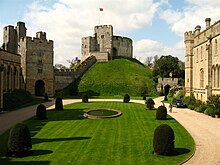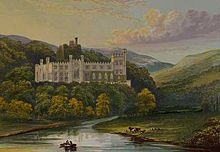Arundel Castle

Arundel Castle in Arundel, West Sussex, England is a restored medieval castle. was founded by Roger de Montgomery on Christmas Day 1067. Roger became the first to hold the earldom of Arundel by the graces of William the Conqueror. The castle was damaged in the English Civil War and then restored in the 18th and 19th centuries.
From the 11th century onward, the castle has served as a hereditary stately home and has been in the family of the Duke of Norfolk for over 800 years. It is still the principal seat of the Norfolk family. It is a Grade I listed building.[1]
Construction
Arundel Castle was first built in 1068 during the reign of William the Conqueror as a fortification for the mouth of the River Arun and a defensive position for the surrounding land against invasion from the Continent. The original structure was a Motte and double Bailey castle. Roger de Montgomery was declared the first Earl of Arundel as the King granted him the property as part of a much larger package of hundreds of manors. Roger was a cousin of William's and had stayed in Normandy to keep the peace there whilst William was off in England. He was rewarded for his loyalty with extensive lands in the Welsh Marches and across the country, together with one third of Sussex. (For other reasons, the generally accepted first creation of the title Earl of Arundel lies in the year 1138 with William d'Aubigny, confirmed in 1155).
After Roger de Montgomery died, the castle reverted to the crown under Henry I. The King, in his will, left Arundel Castle and the attached land to his second wife Adeliza of Louvain. In 1138, three years after Henry's death, she married William d'Albini II (aka d'Aubigny, the first Earl, of the d'Aubigny family of Saint-Martin-d'Aubigny in Normandy). William was responsible for creating the stone shell on the motte, thus increasing the defence and status of the castle.
Changes to the castle — Medieval period

Arundel Castle and the earldom have passed through generations almost directly since 1138, with only the occasional reversion to the crown and other nobles for a brief time. Since the Aubigny family first received the castle, changes have been made and the castle has been re-structured to meet the requirements of the nobility at the present time.
In 1139, the Empress Matilda was invited to stay at Arundel for some time during her travel to press her claim to the English throne upon Stephen. The stone apartments constructed to accommodate the Empress and her entourage survive to this day.
In 1176, William d'Aubigny died and Arundel Castle then reverted to the crown, under Henry II, who spent a vast amount of capital re-structuring the building, mainly for domestic needs. When Henry died, the castle remained in the possession of Richard I ("the Lionheart"), who offered it to the Aubigny family line under William III comte de Sussex. The last in the Aubigny male line was Hugh, who died at a young age in 1243. When his sister Isabel wed John FitzAlan of Clun, the castle and earldom were turned over to him. The FitzAlan family enjoyed an uninterrupted hereditary line until 1580.
Upon the death of the seventh Earl in 1272, Arundel Castle and the earldom passed to his five-year-old son Richard. Thirteen years later, Edward I granted Richard the right to hold two fairs per year at the castle as well as the power to collect taxes. This grant provided funding for the much needed renovation of the castle, which, by this time, had fallen into disrepair. Once sufficient funds were available, FitzAlan added the well tower and re-constructed the entrance to the keep. After Richard's death, his son Edmund was executed for his part in the rebellion against Edward II. Arundel subsequently passed to the 6th son of Edward I who was also executed. The castle and titles passed back to the FitzAlans four years later.
The tenth Earl, Richard, fought at the Crécy with Edward III and the Edward, the Black Prince. FitzAlan was also responsible for the building of the FitzAlan Chapel, built posthumously according to his will.
The eleventh Earl, Richard, was treated harshly by Richard II. At the funeral of the Queen Anne, the Earl was beaten for arriving late and asking to leave early. Richard II eventually grew tired of his treachery and executed the Earl before confiscating his property. Arundel was given by the crown to John Holland, 1st Duke of Exeter, but when he was executed by Henry IV, Arundel was returned to the FitzAlan line once again. The next earl, Thomas, married the daughter of John of Portugal. The couple eventually became the first members of the FitzAlan family to be buried in the chapel built by Richard FitzAlan, the tenth Earl.
The FitzAlan line ceased when Mary FitzAlan, daughter of the nineteenth earl, married Thomas Howard, 4th Duke of Norfolk. The crown seized Arundel upon his execution for conspiring to marry Mary I of Scotland, in 1572. However, the castle was later returned to his heirs, the successor Earls of Arundel.

Restoration of Castle
Although the castle remained in the hands of the Howard family over the succeeding centuries, it was not their favorite residence, and the various Dukes of Norfolk invested their time and energy into improving other ducal estates, including Norfolk House in London and Worksop.
Charles Howard, 11th Duke of Norfolk was known for his restoration work and improvements to the castle beginning in 1787 and continuing for a number of years, as he desired to live there and entertain his visitors there. Many of his improvements have since been revised and remodeled, but the library in the castle is still as he had it designed and built. He held a large party at Arundel Castle to celebrate the 600th anniversary of the signing of Magna Carta shortly before his death in 1815.
Royal visit of 1846
In 1846, Queen Victoria and her husband Prince Albert visited Arundel Castle for a few days. Henry Charles Howard, 13th Duke of Norfolk had remodeled the castle in time for her visit. He was thinking of disposing of some of the 11th Duke of Norfolk's work, as there had been several complaints from the celebrities of the day that it was too cold, dark and unfriendly. The Duke devised a brand new apartment block for the new Queen and her Consort, Prince Albert to stay in, commissioning a portrait of the Queen and decorating the block with the finest of Victorian furniture and art. There was also a re-structuring of bedrooms for the court. The Duke spared no expense to make the Queen's visit enjoyable, and he succeeded.
The Queen was received on December 1, 1846 by the Duke, Mayor of Arundel Edward Howard Howard-Gibbon, and other town dignitaries, and then she retired to her private apartments in the castle. On her visit she walked in the newly designed grounds and visited areas of the county nearby, including Petworth House. Almost every part of the castle that the Queen would visit was re-furbished and exquisitely decorated to meet Royal standards. At the end of her visit, she wrote to the Duke and commented on how enjoyable her visit was, commenting on the "beautiful" castle and the friendliness of her reception. The suite of rooms in which Victoria stayed are now part of the family's private apartments but the suite of bedroom furniture made for her is on display. Among other things to see are the Queen's bed, the guest book bearing her and her Consort's signature and her toilet.
Changes to the castle — 1850 to the present day

Soon after the Royal visit the 14th Duke began re-structuring the castle once again. The 14th Duke died before its completion, and the work was overseen by his successor, the 15th Duke. Work was completed in 1900, and the castle began to look like the amazing architecture on display today. Changes were made to the grounds and he addressed the dark Victorian gardens and made them exquisitely bright and colourful. The problem of light within the castle itself was addressed by the replacement of windows to make the interior brighter. The keep was restructured later on, but the original keep was kept until then for its antiquity and picturesque setting. Today, the castle is still the principal seat of the Dukes of Norfolk, also the Earls Marshal of England.
Tourism
Most of the castle and extensive grounds are open to the general public. There are four varieties of tickets available: bronze - chapel + gardens; silver - bronze + keep; gold - silver + main rooms; gold plus - gold + bedrooms. The sections have different opening times. The private apartments within the quadrangle are not open to the public.
The full tour starts at the south gate and takes in the gardens generally, the Rose Garden, the High Street Lodge gate, the Fitzalan Chapel, the Collector Earl's Garden, the Kitchen Garden, the Victorian Greenhouses, St Mary's Gate and wall, the Bevis Tower (exterior), the Barbican, the Keep on its Motte and the castle interior. The interior tour includes the Stone Hall and Stairs, the Armoury, the Private Chapel, the Barons' Hall, the Picture Gallery, the Dining Room, the Small Drawing Room, the Drawing Room, the Grand Staircase, the Upper Gallery, the York Bedroom suite, the Chester Bedroom suite, the Victoria Rooms, the Ante Library, the Library, the Billiard Room, the South Passage and the Front Hall. There is a gift shop and a restaurant.
Important events
- Marriage of the future Henry IV of England and Mary de Bohun (1380)
- Visit of Queen Victoria and Prince Albert (1846)
- Used as Windsor Castle in the Doctor Who episode Silver Nemesis (1988), in The Madness of King George (1994), in Victoria & Albert (2001 TV serial), and in The Young Victoria (2008).
- Used as Carcroft Castle in the MacGyver television movie Trails to Doomsday.
- Opening of the Collector Earl's Garden 14 May 2008 by Prince Charles
Notes
- ^ "Images of England: Arundel Castle". English Heritage. Retrieved 2007-12-02.
External links
- Arundel Castle
- The Collector Earl's Garden at Arundel Castle
- Arundel Castle entry from The DiCamillo Companion to British & Irish Country Houses
- Map sources for Arundel Castle
- Arundel Castle placemark
- Arundel.TV - Local IPTV Channel
- Arundel Castle on the Patrons and Performances Web Site
- Arundel Castle In April 2008
- The Not So Secret Diary of Queen Victoria
